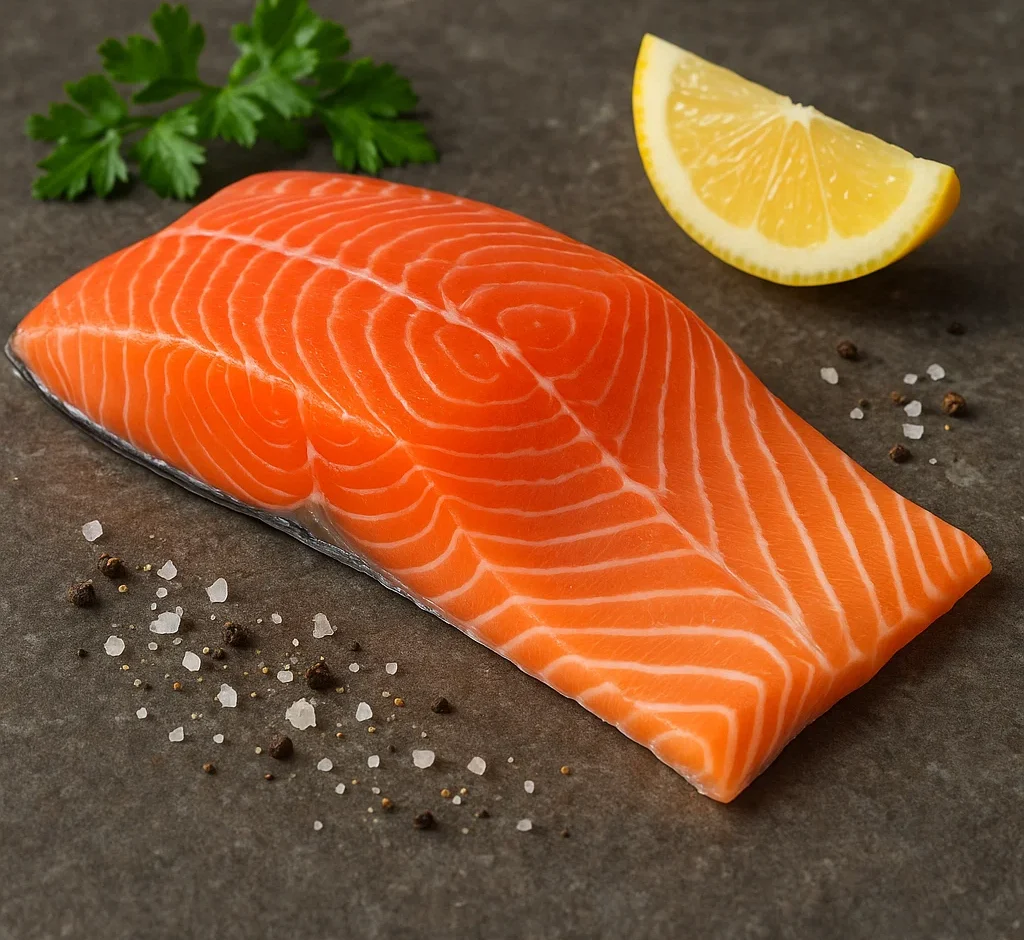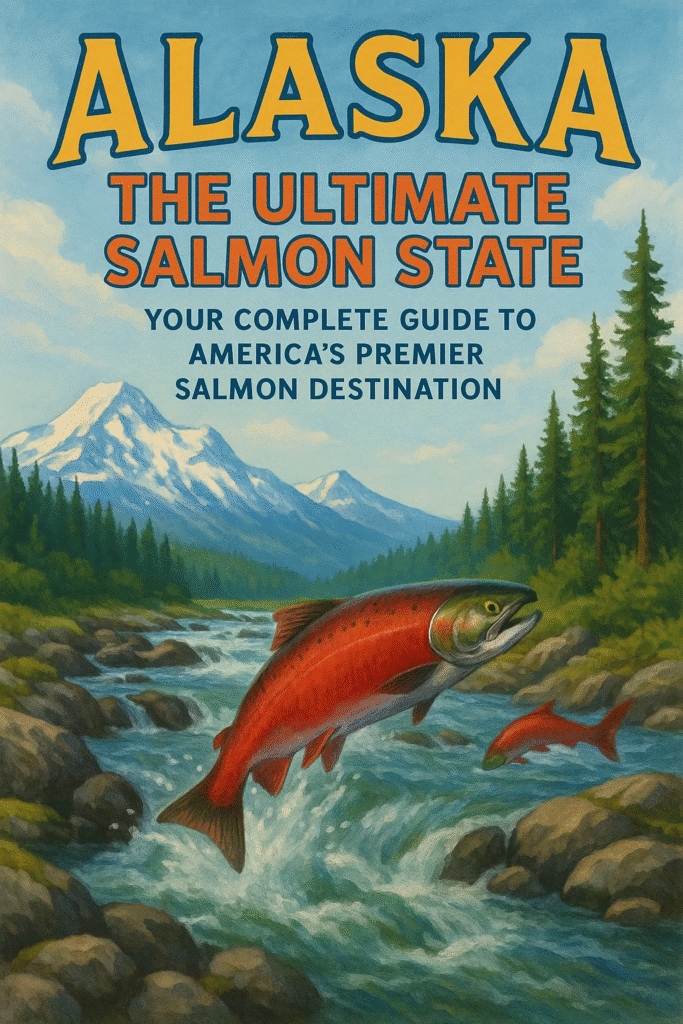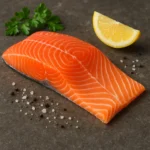Alaska: The Ultimate Salmon State – Your Complete Guide to America’s Premier Salmon Destination
- junio 1, 2025
- 1
- 12 Min Read

Discover why Alaska reigns supreme as the ultimate salmon state, from world-class fishing to unbeatable seafood experiences
When you think of salmon in America, one state immediately comes to mind: Alaska. There’s a reason why Alaska salmon has become synonymous with premium quality seafood worldwide. As someone who’s spent years exploring America’s fishing destinations and sampling salmon from coast to coast, I can confidently say that Alaska truly deserves its title as the ultimate salmon state.
But what makes Alaska so special when it comes to salmon? Is it just the sheer volume of fish, or is there something more that sets this Last Frontier apart from other salmon-producing states? Let me take you on a journey through Alaska’s incredible salmon story – one that spans pristine wilderness, sustainable fishing practices, and some of the most delicious seafood you’ll ever taste.
Why Alaska is Called the Ultimate Salmon State
Alaska isn’t just famous for salmon – it’s absolutely dominant in the industry. The numbers alone tell an incredible story. Alaska produces approximately 60% of America’s commercial salmon, making it not just the ultimate salmon state, but the backbone of the entire U.S. salmon industry.
What truly sets Alaska apart is the pristine environment where these salmon thrive. Unlike many other states where industrial development has impacted waterways, Alaska’s rivers and coastal waters remain largely untouched. The state’s commitment to sustainable fishing practices ensures that future generations will continue to enjoy Alaska salmon at its finest.
I remember my first trip to Alaska’s Kenai Peninsula, watching massive salmon runs that seemed to go on forever. The sheer abundance was breathtaking – something you simply can’t experience in other salmon states. This is what makes Alaska the ultimate salmon state: it’s not just about quantity, but about witnessing nature’s incredible bounty in its most natural form.
Alaska’s Five Spectacular Salmon Species
What makes Alaska the ultimate salmon state isn’t just the volume – it’s the incredible diversity. Alaska is home to all five Pacific salmon species, each offering unique characteristics that seafood lovers cherish:
King Salmon (Chinook) – The Crown Jewel

King salmon from Alaska are legendary among both anglers and food enthusiasts. These magnificent fish can grow over 50 pounds, with rich, buttery flesh that melts in your mouth. The Kenai River holds the world record for the largest sport-caught king salmon at 97 pounds, cementing Alaska’s reputation as the ultimate salmon state for trophy fishing.
Sockeye Salmon (Red Salmon) – The Gourmet’s Choice

Sockeye salmon represent the perfect balance of flavor and nutrition. Their deep red flesh and firm texture make them incredibly popular among chefs and home cooks alike. Alaska’s sockeye runs are so prolific that they supply restaurants worldwide with this premium fish.
Coho Salmon (Silver Salmon) – The Angler’s Favorite

Coho salmon are prized for their fighting spirit and excellent table fare. Alaska’s coho runs provide exciting fishing opportunities from July through September, making the state a premier destination for recreational anglers.
Pink Salmon (Humpback Salmon) – The Abundant One

Pink salmon form the backbone of Alaska’s commercial fishing industry. While smaller than other species, their abundance makes Alaska the ultimate salmon state for commercial production. Every odd-numbered year brings massive pink salmon runs that support thousands of fishing families.
Chum Salmon (Dog Salmon) – The Underrated Gem

Often overlooked, chum salmon from Alaska offer excellent value and unique flavor profiles. Their roe is particularly prized in international markets, adding another dimension to Alaska’s salmon economy.
The Science Behind Alaska’s Salmon Supremacy
Understanding why Alaska is the ultimate salmon state requires looking at the perfect storm of natural conditions that make this possible. Alaska’s geographic location creates an ideal environment for salmon to thrive in ways that other states simply cannot match.
The state’s extensive coastline stretches over 6,600 miles, providing countless spawning streams and rivers. These waterways remain cold and clean year-round, essential conditions for healthy salmon populations. Unlike salmon states in the lower 48, Alaska’s rivers face minimal industrial pollution and urban development pressure.
Alaska’s position in the North Pacific also means its salmon benefit from incredibly nutrient-rich ocean waters. The Gulf of Alaska and Bering Sea provide abundant food sources, allowing salmon to grow larger and develop the rich fat content that makes Alaska salmon so prized by chefs worldwide.
Climate plays a crucial role too. Alaska’s long, cold winters and relatively short summers create the temperature variations that salmon need for their complex life cycles. This natural rhythm, largely undisturbed by human activity, helps maintain the robust salmon populations that make Alaska the ultimate salmon state.
Commercial Fishing: Alaska’s Salmon Industry Powerhouse
The commercial salmon fishing industry in Alaska is nothing short of impressive. As the ultimate salmon state, Alaska’s commercial fisheries extend from the southeastern panhandle near Ketchikan all the way to the remote waters near Kotzebue in the northwest – a span that covers thousands of miles of productive fishing grounds.
What strikes me most about Alaska’s commercial fishing industry is its commitment to sustainability. Unlike some other fishing operations I’ve observed in different states, Alaska’s salmon fisheries operate under some of the strictest management protocols in the world. This approach ensures that Alaska maintains its status as the ultimate salmon state for generations to come.
The Alaska Department of Fish and Game closely monitors salmon runs, adjusting fishing quotas based on real-time population data. This scientific approach to management is one reason why Alaska salmon populations remain healthy while other states have seen declines.
The economic impact is staggering. Alaska’s salmon industry supports thousands of jobs, from commercial fishermen to processing plant workers to the countless businesses that support the industry. Small fishing communities throughout Alaska depend on salmon seasons, making this fish not just an economic engine, but the lifeblood of many Alaskan communities.
Sport Fishing Paradise: Why Anglers Choose Alaska
As an avid angler, I can tell you that Alaska offers fishing experiences you simply cannot find anywhere else. The state’s reputation as the ultimate salmon state isn’t just about commercial fishing – it’s also about providing world-class recreational fishing opportunities.
The Kenai River alone attracts thousands of anglers each year, all hoping to land a trophy king salmon. But Alaska’s fishing opportunities extend far beyond this famous river. From the remote streams of Bristol Bay to the coastal waters of Southeast Alaska, the state offers salmon fishing adventures for every skill level and preference.
What makes Alaska special for sport fishing is the combination of fish size, abundance, and pristine wilderness settings. Where else can you catch salmon while watching eagles soar overhead and bears fish alongside you? This wild Alaska experience is what separates the ultimate salmon state from more developed fishing destinations.
The guides and outfitters in Alaska are world-class professionals who understand both the fishing and the environment. They’ve helped me land some of my most memorable salmon, while sharing knowledge about sustainable fishing practices and Alaska’s incredible ecosystem.
Alaska Salmon in Your Kitchen: From Ocean to Table
One of the things that makes Alaska the ultimate salmon state isn’t just the fishing – it’s the incredible culinary experience these fish provide. Alaska salmon has a flavor profile that’s distinctly different from salmon caught in other waters, and once you’ve tasted it, you’ll understand why chefs worldwide specifically seek out Alaska salmon.
The cold, clean waters of Alaska produce salmon with firm flesh and rich flavor. The high fat content, developed during their ocean feeding phase, creates that buttery texture that makes Alaska salmon so prized. Whether you’re grilling, baking, or preparing sushi, Alaska salmon delivers superior results every time.
I’ve cooked salmon from various states, but Alaska salmon consistently performs better in the kitchen. It holds together well during cooking, doesn’t become dry as easily, and has a clean, oceanic flavor without any muddy or fishy undertones that can plague salmon from warmer, less pristine waters.
The nutritional benefits of Alaska salmon are exceptional too. High in omega-3 fatty acids, protein, and essential vitamins, Alaska salmon represents one of nature’s perfect foods. Knowing that this salmon comes from pristine, unpolluted waters gives me additional confidence in serving it to my family.
Sustainable Practices: Protecting Alaska’s Salmon Legacy
What truly makes Alaska the ultimate salmon state is its unwavering commitment to sustainability. I’ve witnessed firsthand how Alaska manages its salmon resources, and it’s impressive to see science-based conservation in action.
Alaska’s salmon management system is considered the gold standard worldwide. The state constitution actually mandates that fisheries be managed for maximum sustained yield, ensuring that short-term profits never compromise long-term sustainability. This forward-thinking approach has kept Alaska’s salmon populations healthy while other regions have struggled.
The Alaska Salmon Program includes extensive research, habitat protection, and careful monitoring of fishing pressure. Biologists track salmon runs in real-time, adjusting fishing quotas to ensure adequate spawning populations. This scientific approach is what allows Alaska to maintain its position as the ultimate salmon state year after year.
Fish ladders, habitat restoration projects, and strict pollution controls all contribute to maintaining the pristine environment that Alaska salmon need to thrive. It’s refreshing to see an industry that truly understands the connection between environmental health and long-term economic success.
Planning Your Alaska Salmon Adventure
If you’re inspired to experience Alaska as the ultimate salmon state firsthand, proper planning makes all the difference. Having organized several Alaska fishing trips, I can share some insights that will help you make the most of your salmon adventure.
Timing is crucial for Alaska salmon fishing. Different species have different run times, so your target fish should determine when you visit. King salmon typically run from May through July, while silver salmon are best from July through September. Pink salmon have strong runs in odd-numbered years, while sockeye salmon timing varies by location.
Choosing the right location within Alaska is equally important. The Kenai Peninsula offers excellent road access and developed infrastructure, making it perfect for families or first-time visitors. For a more remote experience, consider Bristol Bay or Southeast Alaska, where you’ll fish in truly pristine wilderness settings.
Don’t forget that Alaska is still wild country. Weather can change quickly, and you’ll need appropriate gear for conditions. A good guide service will provide equipment lists and local knowledge that can make your trip both successful and safe.
The Economic Impact of Alaska’s Salmon Industry
Understanding Alaska as the ultimate salmon state requires appreciating the massive economic impact of its salmon industry. The numbers are truly staggering and help explain why salmon fishing is so integral to Alaska’s identity and economy.
Alaska’s salmon industry generates billions of dollars annually, supporting not just direct fishing jobs but an entire ecosystem of related businesses. Processing plants, equipment suppliers, transportation companies, and tourism businesses all depend on Alaska’s salmon runs.
The ripple effects extend far beyond Alaska’s borders too. Alaska salmon supports restaurants, grocery stores, and seafood distributors throughout North America and beyond. When you order salmon at a high-end restaurant in New York or buy frozen salmon at your local grocery store, there’s a good chance it came from Alaska.
This economic impact helps fund the research and management programs that keep Alaska’s salmon populations healthy. It’s a perfect example of how sustainable resource management can create long-term economic benefits while protecting the environment.

Comparing Alaska to Other Salmon States
While other states certainly have their salmon fishing opportunities, Alaska’s dominance as the ultimate salmon state becomes clear when you make direct comparisons. I’ve fished for salmon in Washington, Oregon, and California, and while each has its merits, none can match Alaska’s combination of abundance, size, and pristine environment.
Washington State has excellent salmon fishing, particularly in Puget Sound and the Columbia River system. However, urban development and dam construction have impacted many of Washington’s salmon runs. The fish are often smaller, and the fishing pressure is much higher than what you’ll find in Alaska.
Oregon offers beautiful coastal salmon fishing and some excellent river systems. The salmon here can be quite good, but again, the runs are smaller and more pressured than Alaska’s massive populations. Environmental challenges have also impacted Oregon’s salmon recovery efforts.
California’s salmon fishing can be excellent in good years, but the state faces significant challenges from drought, habitat loss, and competing water demands. Alaska’s advantage lies in its vast, largely undeveloped landscape that provides ideal salmon habitat.
The Future of Alaska as the Ultimate Salmon State
Looking ahead, Alaska’s position as the ultimate salmon state seems secure, thanks to strong management practices and constitutional protections for fisheries. However, challenges exist that require continued vigilance and adaptation.
Climate change represents the biggest long-term challenge for Alaska’s salmon populations. Warming waters and changing ocean conditions could impact food sources and migration patterns. However, Alaska’s diverse salmon habitats and strong populations provide resilience that many other regions lack.
The state continues to invest in research and habitat protection programs that will help salmon populations adapt to changing conditions. New technologies for monitoring fish populations and ocean conditions are being implemented to improve management decisions.
Alaska’s commitment to sustainable fishing practices positions the state well for the future. Unlike regions that prioritized short-term profits over long-term sustainability, Alaska has built an industry designed to last for generations.
Conclusion: Alaska’s Salmon Legacy
After exploring salmon destinations throughout North America, I can confidently say that Alaska truly deserves its reputation as the ultimate salmon state. The combination of pristine environment, abundant fish populations, sustainable management practices, and incredible fishing experiences creates something truly special.
Whether you’re a commercial fisherman, recreational angler, seafood enthusiast, or simply someone who appreciates nature’s bounty, Alaska offers salmon experiences that simply cannot be matched elsewhere. The state’s commitment to maintaining healthy salmon populations ensures that future generations will continue to enjoy Alaska as the ultimate salmon state.
From the massive king salmon of the Kenai River to the abundant sockeye runs of Bristol Bay, Alaska continues to set the standard for what salmon fishing should be. It’s not just about the size or number of fish – it’s about experiencing salmon in their most natural, pristine environment.
Alaska is more than just the ultimate salmon state – it’s a testament to what’s possible when we prioritize conservation, sustainability, and respect for nature’s incredible bounty. For anyone passionate about salmon, Alaska isn’t just a destination – it’s a pilgrimage to the heart of America’s salmon kingdom.















Comentarios de 1
Absolutely loved this guide! 🐟✨ Alaska truly is the ultimate destination for salmon lovers. The way you broke down the regions, types of salmon, and the best fishing seasons was super helpful. Planning my dream trip already — can’t wait to taste the freshest wild salmon right where it’s caught! 👏🔥